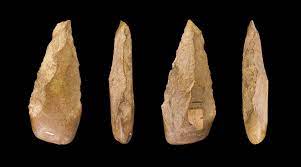Palaeolithic
- Archaeologists have given lengthy names for the time that we are studying.
- They call the earliest period the Palaeolithic.
- This comes from two Greek Words, ‘palaeo’, meaning old, and ‘lithos’, meaning stone.
- The Palaeolithic period extends from 2 million years ago to about 12,000 years ago.
- This long span of time covers 99% of human history.
- In the Old Stone Age, food was obtained by hunting animals and gathering edible plants and tubers.

Mesolithic
- The period when we find the beginning of environmental changes.
- 12,000 years ago till about 10,000 years ago is called the Mesolithic (middle stone).
- Stone tools found during this period are generally tiny, and are called microliths.
Neolithic
- It is approximately dated from 6000 B.C to 4000 B.C.
- Neolithic remains are found in various parts of India.
- These include the Kashmir valley, Chirand in Bihar, Belan valley in Uttar Pradesh and in several places of the Deccan.
- Domestication of animals was started at the end of Mesolithic period and it was in large scale in Neolithic culture.
- The chief characteristic features of the Neolithic culture are the practice of agriculture, domestication of animals, polishing of stone tools and the manufacture of pottery.
- Cattle were used for cultivation and for transport.
- The people of Neolithic Age used clothes made of cotton and wool.
Metal Age
- The Neolithic period is followed by Chalcolithic (copper-stone) period when copper and bronze came to be used.
- The new technology of smelting metal ore and crafting metal artifacts is an important development in human civilization.
- The Chalcolithic age is followed by Iron Age.
- Iron is frequently referred to in the Vedas.
- The Iron Age of the southern peninsula is often related to Megalithic Burials. Megalith means Large Stone.
- The burial pits were covered with these stones. Such graves are extensively found in South India. Some of the important megalithic sites are Hallur and Maski in Karnataka, Nagarjunakonda in Andhra Pradesh and Adichchanallur in Tamil Nadu.
- Black and red pottery, iron artifacts such as hoes and sickles and small weapons were found in the burial pits.
- Vedic period corresponds to Iron Age.
Important Links